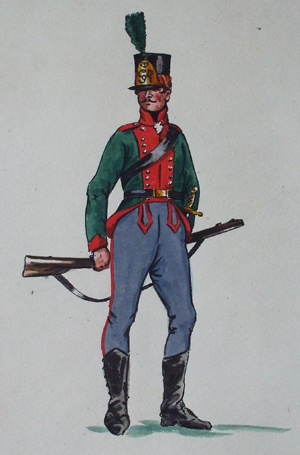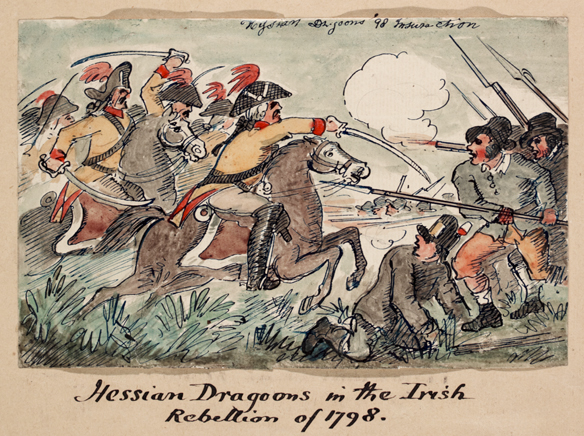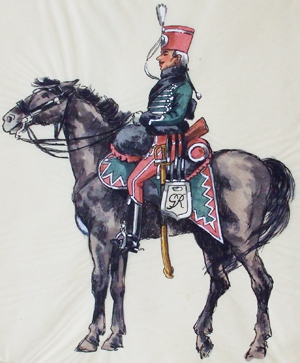Catholic ‘Hessians’?
Published in Features, Issue 5 (September/October 2019), Volume 27‘At Tubberneering and Ballyellis
Full many a Hessian lay in his gore’
By Nicholas Dunne-Lynch
The ballad Boolevogue, which celebrates the heroism of the Wexford rebels during the rebellion of 1798, and in particular the campaign of Fr John Murphy from 26 May to 26 June, contains the lines quoted above. Written by Patrick Joseph McCall in 1898 to mark the centenary, the ballad subsequently became so popular that it was hugely influential in shaping perceptions of the rebellion in Wexford. But how accurate is it in relation to ‘Hessians’?
The ambush at Tubberneering (or Clough) on 4 June 1798 was indeed led by Murphy but was not his first success against government forces, which had been at Oulart Hill on 27 May. None of the force opposing the rebels at Tubberneering can be described as ‘Hessians’.
After the rebel defeat at Vinegar Hill on 21 June and with his options diminishing after his having failed to lead the colliers of the Castlecomer–Doonane area of Kilkenny into rebellion, Murphy led his men back across the Barrow at Goresbridge to re-enter County Carlow and, if possible, fall back into County Wexford. Separated from his army during the clash at Kilcumney Hill on 26 June, when the rebels were routed in a surprise attack by a government force, Murphy was captured and reportedly executed at Tullow on 2 July.
In the meantime, however, on 30 June at Ballyellis, just inside County Wicklow, a force of rebels under Joseph Holt ambushed and routed a government column that contained a detachment of the ‘Ancient Britons’. Both the clashes at Tubberneering and Ballyellis were rebel successes and were thus incorporated into the ballad and woven into popular history. The Ancient Britons, a fencible dragoon regiment from north Wales formed in 1794, became infamous in County Wexford and beyond and are mentioned in his memoir by Miles Byrne, who reports that ‘an uncle and his son-in-law, gentlemen of Wexford county, were shot down in cold blood at their own doors by a detachment of the “Ancient Britons” lest they might have been perhaps implicated in the United Irish society, or would, could, or should be thereafter implicated’.
Who were the ‘Hessians’?

Above: Uniform of the Hompesch Rifles (5th Battalion, 60th Regiment of Foot, Royal Americans). In pursuit of Humbert’s invading force in Connacht, they embellished their severe reputation, summarily hanging rebels who approached them thinking, on account of their unusual uniforms, that they were French troops. (Bibliothèque et archives du Musée de Condé, Château de Chantilly)
The government troops popularly referred to as ‘Hessians’ with both contempt and dread were the Hompesch Mounted Rifles and the 5th Battalion of the 60th Regiment of Foot, Royal Americans. The 5/60th was also equipped with rifles—that is, rifled barrels with greater accuracy and range than smooth-bore muskets—and was probably the first battalion to be thus equipped in the British Army, descending from the central European tradition of jaegers (hunters), the original light troops which the British Army would soon develop on a larger scale with the 95th Regiment, later the Rifle Brigade.
A document recently discovered by the present author in French archives, reportedly a transcription of an original manuscript in the Belgian military archives, is an account by a captain named de Villiers Masburgh, a native of the province of Luxembourg, part of Belgium today, who describes how, in the West Indies in January 1798, 700 supernumeraries of the mounted Hompesch were formed into the 5/60th infantry while 400 remained in the mounted corps. Both corps arrived in Ireland in April 1798, Villiers commanding a company of the 5/60th. Although they were present at the outbreak of the rebellion, neither the Mounted Rifles nor the 5/60th engaged in combat until late June, when they were divided between the forces of Lake and Moore in the suppression of the Wexford rising. It was normal to divide such troops, usually in the vanguard or the rearguard, fighting in skirmish or in open order, several of the ten companies of the 5/60th deploying in each army.
Instilled terror
Villiers was aware of the dread that his corps instilled, always insisting that their action was essential in the suppression and even the prevention of rebellion, and generally appears unrepentant; for example, recalling the action of his unit around Foulksmills, he records:
‘We first pillaged their camp [of the defeated rebels], where they had erected altars with many church ornaments; their tents were put to the torch. This terrorized the area, orders having been given to burn the barracks and the dwellings of the inhabitants of the town where pikes were found, which were carried out immediately. It is painful to take such extreme measures, but necessity required it, for such severe action terrorizes [the people] and soon suppresses insurrection and serves as a warning to the rest of the country. All men with weapons in their hands scattered across the country were pursued, and those we apprehended were sent back to New-Ross, where a court martial was established at which they were judged without delay and hanged. That day, we killed or took about 700, rounded up by our mounted troops, which terrorized the whole county and made us formidable without further effort.’
In addition, in support of the reputation that the Hompesch had earned, Villiers reports no less a witness than the surrendered rebel leader Fr Philip Roche:
‘Roche, brave and resolute, having been condemned [to death] declared to General Hompesch that it was his troops that caused Roche’s misfortune and brought an end to the rebellion so suddenly, that the terror they had inspired in his rebels was so great that he could not, at the sight of our chasseurs, re-encourage them and keep them together.’
Villiers also claimed that their harshness was, in part, reprisal for attacks on their outposts and the slaying of Hompesch sentries.

Above: Uniform of the Hompesch Rifles (5th Battalion, 60th Regiment of Foot, Royal Americans). In pursuit of Humbert’s invading force in Connacht, they embellished their severe reputation, summarily hanging rebels who approached them thinking, on account of their unusual uniforms, that they were French troops. (Bibliothèque et archives du Musée de Condé, Château de Chantilly)
Under Sir John Moore, ‘Hessians’ took part in the attempted suppression of the Wicklow mountain rebels Holt and Dwyer. Moore eventually decided against pursuit, withdrawing his troops to Blessington, and when news of Humbert’s invasion reached Dublin he marched west, travelling by canal barges from Sallins, Co. Kildare, to Tullamore, King’s County. In pursuit of Humbert’s invading force in Connacht, the 5/60th embellished its severe reputation, summarily hanging rebels who approached them thinking, on account of their unusual uniforms, that they were French troops.
Strong Catholic element
It is in relating an earlier incident, however, that the Villiers account will seem most bizarre to Irish eyes. The Hompesch had a strong Catholic element, including Villiers himself, who attended Mass regularly among the local people at Rathdrum, Co. Wicklow. He reports:
‘Having been there on Sundays and feasts, four or five officers, and some of our company attended church to hear Mass, which made such an impression on this fanatical people, having seen that we were Catholics like them, that we inspired them with trust, and, considering us with respect, this encouraged them to bring in their arms, leave the rebels and return to order. They also brought us food in abundance and often would not accept payment.’
Perhaps more surprisingly, the Hompesch Mounted Rifles also contained Catholic officers. Prominent among these was Bryan O’Toole, a native of County Wexford, who had served with Walsh’s Regiment in the Irish Brigade in France but had returned to Ireland in 1793 with the defecting regiments that had first become part of the counter-revolutionary Armée de Condé and, in 1794, joined the Irish Catholic Brigade in the British Army. On the disbandment of this corps in 1797, O’Toole had been commissioned into the Hompesch. Villiers writes that, after the battle of Ballinamuck, O’Toole’s troop captured 400 rebels, and these may have been among those summarily executed. O’Toole went on to serve under Wellington in the Peninsular War and later rose to the rank of major-general. His family complained that his career was retarded by his religion, while another salient fact that, as a Catholic, he served with the dreaded ‘Hessians’ has been largely written out of Irish history. The wounded Villiers left Ireland in September 1798 and consequently retired from the British Army. The 60th Regiment went on to be a founding element of the King’s Royal Rifle Corps.
Mercenaries?

Above: Uniform of the Hompesch Mounted Rifles (Hussars). (Bibliothèque et archives du Musée de Condé, Château de Chantilly)
As late as 2005, the Carlow Nationalist declared:
‘When we spoke to the different areas that suffered at the hands of the victors [in the 1798 Rebellion], we were told that the area around Wexford Town suffered more than most. This area was patrolled by German mercenaries who went on a rampage of pillage and terrorizing the local population.’
This is clearly intended to mean ‘Hessians,’ since there were no other troops that can be described as German—either German-speaking or with origins in Germanic states. Villiers notes, however, that he had Austrian and Hungarian troops under his command. The term ‘Hessian’, of course, derives from troops from the state of Hesse-Cassel employed by the British to assist in its effort to suppress the American independence movement, some of whom settled in the United States after the war. These Hessians were not mercenaries in the accepted sense of the word, since the units retained their national status and the individual soldier derived no financial benefit, which accrued only to the Landgrave (prince) of Hesse-Cassel. The term ‘Hessian’ as a pejorative seems to have arisen in Ireland during or after the rebellion of 1798.
Many atrocities in that year, committed by local yeomanry or by other corps such as the Ancient Britons, may have been falsely attributed to the Hompesch or the 5/60th. Although Villiers reports that the two Hompesch units were dubbed ‘Hessians’, he does not comment on the rampaging reported by the Nationalist; this may have been the work of Wexford units, but since these were local men, many of them also Catholic, it was better to blame their atrocities on foreigners.
Nicholas Dunne-Lynch’s book on Napoleon’s Irish Legion will be published shortly by McFarland.
FURTHER READING
C.T. Atkinson, ‘Foreign regiments in the British Army, 1793–1802: Part IV—The West Indies’, Journal of the Society for Army Historical Research 22 (87) (1943).
S. Cloney, ‘The Hessians’, Journal of the Wexford Historical Society 14 (1992–3).
G.A. Hayes-McCoy, ‘The government forces which opposed the Irish insurgents in 1798’, The Irish Sword 4 (14) (1959).
‘Journal du Capitaine de Villiers Masburgh’ (COA 30/12/1797), Musée de l’Armée de Bruxelles (transcription, Vicomte Grouvel, Bibliothèque et archives du Musée de Condé, Château de Chantilly, France, 1 GR 125).
















